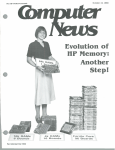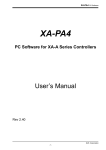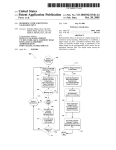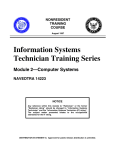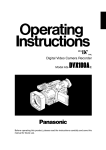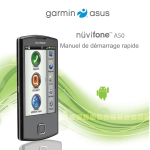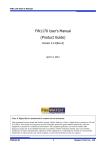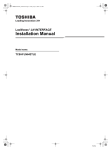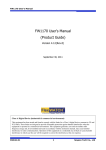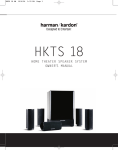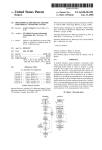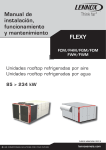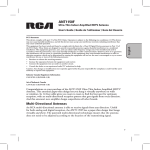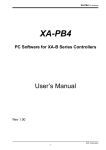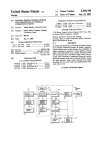Download Simultaneous multidirectional communication apparatus
Transcript
USOO5867768A Ulllted States Patent [19] [11] Patent Number: Onda [45] [54] SIMULTANEOUS MULTIDIRECTIONAL 5,404,577 5,438,702 5,586,176 _ [57] [51] [52] [58] Jackson ......... .. .. 455/575 Peck ...................................... .. 455/568 ABSTRACT A communication apparatus includes a plurality of transmitter-receivers operatively coupled together so that they are simultaneously communicatable over-the-air With one another by Way of an interexchange repeater module, Foreign Application Priority Data [JP] [JP] 4/1995 Zuckerman et a1. .................... .. 455/66 8/1995 12/1996 Attorney, Agent, or Firm—Morgan & Finnegan, LLP [21] Appl- N05 711,550 [22] Filed: Sep_ 10, 1996 Sep.13,1995 Jun. 12, 1996 Feb. 2, 1999 Primary Examiner_w?lis R_ Wolfe _ [73] Ass1gnee: Baldwin-Japan, Ltd., Tokyo, Japan [30] Date of Patent: COMMUNICATION APPARATUS [75] Inventor: Takeo Onda, Fujimi, Japan 5,867,768 Int. Cl.6 ..................................................... .. H04B 1/38 US. Cl. ............................ .. 455/66; 455/575; 455/90; 455/568 Field of Search ................................ .. 455/66, 88, 90, wherein 0n? of Such trtnsmitter'rectivers Comes With a dlsplay devlce for Provldmg lnfermanon to th‘? user’ 219d a telephone connector for connecting the transmitter-receiver to the public telephone communication network. A sound shielded headset is employed in the transmitter-receiver. This headset includes an audio input/output section With a microphonea Speakers and the likea and a transmitter/receiver 455/463, 500, 503, 526, 575, 568, 507, function section for executing signal processing tasks 517, 351 required for communications. Upon reception of a telephone signal, the transmitter-receiver is connected to the telephone [56] Japan .................................. .. 7-259502 Japan .................................. .. 8-172935 References Cited connector by means of a cable-Wiring, optical coupling or radio-Wave coupling scheme providing voice communica U'S' PATENT DOCUMENTS tions With the outside parties. In case Where the telephone 3,845,389 10/1974 Phillips et a1. ........................ .. 455/568 4,357,711 11/1982 Drefko et a1, __ 455/575 5,113,428 5/1992 Fitzgerald ....... .. 455/568 5,119,505 6/1992 Tisseront et a1. . Connector is 9(11111111991 With a known telephone Set, voice communications Will be available by entry of phone num bers over either external public lines or extension lines. 455/568 5,359,647 10/1994 Regen et a1. .......................... .. 455/568 21 Claims, 11 Drawing Sheets 7 drsplay device /\/ \|\ l. ___________________ _. _ . |- external srqnal Input _l i report IA, acknowledgemen r i \ _ _ - 2‘ I . —l——-———> : }?:l:c0mmun|cat|un1|_) ?gmjegtpr | ev‘ce !I operatlon . section ' li 6 8 | | - . I I | I telephone set l \]\ BGM ——————>i telephone ! 5 repeater 10 22 k ey power <__l suppl)! 14 ' \1 o ~ 3\ \I\ . _____________________ _.l 2n battery charge station 2/ U.S. Patent Feb. 2, 1999 Sheet 1 0f 11 $7511... W 7 5,867,768 ? 53mg: @>320 :23 If;vI. 2:2; 2 :32. F..|,IL w_ 2_35m2;.2;3 J m2 538 " 2:3;: _ _ _ _ _ __ 22222:5 _ _ m _ m c _ w 2:52 _2_ .29:25aE. _ 03m3_2 8 U.S. Patent Feb. 2, 1999 Sheet 2 0f 11 F - - _ - 7 1 : disp | ay / I device ' ——1——' l1 \ external external 5,867,768 ‘PPM i nput - s I 9"‘!I 5mm, | : detector ' ‘ control ler / / 13 password i nput ' operat i on section external i nt|>ut se ect signa I key 10 \ 12a 14 transmitter/receiver section repeater 1/ \ i2 FIG.2 U.S. Patent Feb. 2, 1999 4 Sheet 3 0f 11 5,867,768 1 45 external \ input 41 12a 46 _—§1 repeater -lA telephone 'FEl. function section l/L a c \ St ‘ 42a f1 connector I T A: Z: 47 J;::]microphone 8 speaker 24 z// /fi connector 27 connection detector \\\ 25 22 ‘\“\\\\_ AFsection sw'tch'ng seétioa 21a transmission/ interruption signal 26 \\\\\ transmitter/receiver connector section microphone speaker FIG.3 I 21 U.S. Patent Feb. 2, 1999 Sheet 4 0f 11 5,867,768 72 n \ indicator lamp device 1 device 2 73 device 8 / device A 7-1 _ repeater external input signal FIG.4 / I telephone U.S. Patent Feb. 2, 1999 Sheet 5 0f 11 5,867,768 Q56 23 2 _ _ _ _ _ _ _ _ _| switching ' 7/ /‘r_|Jl section Il : b 2 (be: blx Ago "?g-"c 22 xx AF sect ion —/\—— mm 25 transmission operation transmission interrupt . 26 i; \ \ transmitter/race i ver connector sect ion 95 microphone speaker FIG, 5 /2‘ 21a U.S. Patent Feb. 2, 1999 Sheet 7 of 11 \1 5,867,768 45 M EH» repeater A6 \FL telephone TEL function U section A A switch section 2 optical connector 47 communication SENIOR receiver Pmicrophone a; aspeaker so 49 5 2\ 29/ remoted comman er optical communication section 28/ 25 22 w . \ AF sect ion switching Section 21a transmission/ interruption signa I 26 \ transmitter/receiver section connector I iA / microphone speaker FIG.7 2‘ U.S. Patent Feb. 2, 1999 Sheet 8 0f 11 41 \|:|——>repeater 46 \r'l telephone TEL 5,867,768 funct ion section U swi tch sect ion / 42A transmitter/ T receiver connector I receiver L sect ion \ A; A \ 47 Fmicrophone\speaker 50 5t 5 2 \ 29/ remoted common er transmi tter/ receiver T / sect ion 52 25 22 \ . \ AF sect ion switching Sect ion 21a transmission/ interruption s‘ na 26\ ‘9 transmitter/receiver \ sect ion connector microphone speaker FlG.8 / 21 U.S. Patent Feb. 2, 1999 Sheet 9 0f 11 4 5,867,768 1\ telephone 12a repeater connector 6 23 2 24 / / / connector 27 -connection \\\ detector 25 ‘( 3] l//,/// transmitter/ switching receiver section ///lsection 216 transmission/ interruption signal transmitter/receiver section / 21 62 30 64 22 63 60 FIG.9 61 U.S. Patent Feb. 2, 1999 Sheet 10 0f 11 _____1 5,867,768 : display I/ I 11 vice ' - - 7 - -' \ externa l / input : connector : 1 device input detector ' telephone ' /13 password signal 1 7 control Ier | ‘ ' ‘ ' T— operat i on section 4 external input select s i gna | key \ 10 < 14 / /15 dist r i butor/mixer transmi tter/rece i ver section repeater \ 1/ \ 12a Y/ U.S. Patent Feb. 2, 1999 Sheet 11 0f 11 Y \ i/21 1 \ repeater Power supply 5,867,768 \I\ <_____ . 2n battery charge station /, FlG.11 PRIOR ART 5,867,768 1 2 SIMULTANEOUS MULTIDIRECTIONAL COMMUNICATION APPARATUS so-called “sound-insulated” transmitter-receivers for use in Working under noisy conditions, successful results are only be achieved by employing Workers’ case-by-case BACKGROUND OF THE INVENTION procedures, Which expect a Worker Who received a telephone call to i) use a selected telephone line being exclusively connected to the repeater, ii) catch the call using a 1. Field of the Invention This invention relates to telecommunication apparatus transmitter-receiver that is presently in the out-of-busy state, adaptable for use in noisy environments including furnace factories, sheet-metal or Web production Workplaces such as press-Working, airplane setup/maintenance Works in the airport, print/press factories, and the like, and, more par 10 ticularly to voice communications apparatus capable of attaining successful transmission of voice messages and factory in order to hook up the telephone handset; it may alternatively occur that s/he has to go out of the factory to use one of remotely located telephones in calm areas outside phone-calls under high noisy conditions. 2. Description of the Related Art or iii) ask his or her associate to separately connect With the calle. It Will also occur that the called party must put his/her upper body or head into a sound-shielded box Within the the factory. The prior art sound-insulated transmitter receivers are unable to insure direct telecommunications 15 plary apparatus for such sound-insulated transmitter With external telephones as linked by Way of the public telecommunication netWorks; accordingly, it Will be inevi table for Workers to interrupt their oWn Works until comple tion of the present conversation betWeen the caller and the called party over telephone, or to temporarily change the receiver is shoWn in FIG. 11. In this apparatus a plurality of Work to a different kind of one that may be done Without the transmitter-receiver 2 (21, 22, . . . , 2n) are operatively need of attendance of the calling or called Worker. In any Way, this should result in a decrease in ef?ciency of Work Conventionally, portable radiotelephones using a sound shielded headset (sound-insulated transmitter-receiver) are employed as the communication means betWeen Workers under noisy conditions full of ambient noises. One exem coupled over-the-air to one another using radio Waves by Way of a repeater 1. Any audio messages sent form the repeater 1 may be heard at all of the transmitter-receivers 2 providing simultaneous multidirectional communications. A ability. 25 battery-charge station 3 charges the batteries of respective transmitter-receivers. Each transmitter-receiver 2 is provided With a headset of excellent sound insulation, Which consists of a pad section, a support member and others. This headset is of the head inspection device (PQD) for inspection of printing machines or a spray dampener (SD) experiences failures accidentally, the resulting printing matter Will be expressly loWered in quality causing the productivity to decrease signi?cantly. To phone type containing therein a microphone, a speaker(s), and a transmitter/receiver function section. Factory Workers use such headphones by putting them on their heads to enable simultaneous multidirectional conversations to be Under high noisy circumstances it is required that, upon occurrence of failures in Working machines, such informa tion be rapidly informed to Workers so that necessary recovery/repairing procedures can be applied at the earliest convenience. One example is that When a paper quality eliminate such reduction in productivity, rapid handling for 35 carried out attaining required voice communications among them. The microphone detects ear-bone vibrations upon recovery is strictly required at any events. It is therefore an object of the present invention to provide a communications apparatus capable of retaining reliable communicationability With outside parties in situ under noisy circumstances by letting a repeater have a function of transferring information identical to any external signal inputs toWard all of the transmitter-receivers operatively coupled thereWith in the apparatus. occurrence of a voice message and convert it into a corre sponding electrical signal. In the case Where a telephone call is made in noisy environments of relatively higher noise level, it Will possibly happen that the microphone also picks up the ambient sounds making it dif?cult for a Worker to hear his or her It is another object of the invention to provide a voice aimed voice messages due to masking effects of background communications apparatus capable of alloWing Workers to noises. Under such conditions, it is no longer easy for a Worker to accurately transfer his or her voice messages; this necessitates a called party to ansWer back the caller for con?rmation, Wasting time and effort With the result in an 45 interconnectivity betWeen sound-insulated transmitter/ receivers and telephone connector devices. It is yet another object of the invention to provide a voice communications apparatus capable of attaining conversa tions over public or extension telecommunication lines by entering telephone numbers on part of a telephone operation increase in conversation time While reducing ef?ciency. One prior knoWn approach for avoiding the problems is to install telephone booths of a sealed environment; another approach is to put each telephone set at a location of relatively loW panel of a telephone connector device to ensure that Workers can call a target party under noisy in-situ conditions Without noise levels. Unfortunately, such approaches cannot alWays offer intended advantages on occasions Where there are no such spaces Wide enough to permit location of the telephone 55 booth, or on occasions Where such ideally loW-noise places are not available Within the factory. If this is the case, it is a must to put the telephones at noisy locations, Which lacks the ability to provide any satis?able conditions for Workers to telecommunicate With each other. having to move far from their original Working places during operations. It is a still another object of the invention to provide voice communications apparatus capable of immediate start of conversations in situ over telephone upon reception of a telephone call While providing as needed the possibility of simultaneous multidirectional transmission/reception of oral Incidentally, there has been long desired a speci?c type of telephone handset suitably adaptable for use in voice com messages among a plurality of transmitter-receiver users concerned, to thereby suppress or eliminate degradation of munications in noisy environments namely, the one that can ef?ciency otherWise occurring When a Worker must move far be directly installed under high noisy conditions and also attain clear conversations Without having to be interfered With mixture of background noises With no interruptions in intended telecommunications. On the other hand, in the call over telecommunication channels under noisy in-situ conditions by providing an extra function for enabling 65 from his or her Working place for telephone calls. It is a further object of the invention to provide a tele communications apparatus capable of retaining security for 5,867,768 4 3 covert conversations While preventing leakage of informa tion content to other transmitter-receivers by forcing upon means, Wherein informing of telephone reception or receipt of a telephone call a communication function to be interrupted betWeen the transmitter-receiver of a called party using sounds and/or visual indications. abnormality Warning in the machinery equipment is done (7) The repeater comes With a communication section for enabling the oWner of a telephone connected With the telephone line to telecommunicate With one or a plurality of transmitter-receiver users by Way of the repeater. (8) Each transmitter-receiver includes a means for causing the communication functions to break off betWeen it and other transmitter-receivers When connected to the tele phone connector device, and a means for resetting the and other transmitter-receivers, and also capable of main taining mutual communication functions among the other transmitter-receivers to alloW these transmitter-receivers to continuously remain active in telecommunications among them thus eliminating any possible interruptions in execu tion of Works required. It is a yet further object of the invention to provide a communication functions therebetWeen by disconnecting telecommunications apparatus capable of alloWing tele the connection With the telephone connector. (9) The repeater has a communication retaining function of enabling, When one transmitter-receiver is coupled to the telephone connector, communications among the other transmitter-receivers. (10) The display means includes an indication lamp that phone responses and call-up of a target party to be smoothly carried out by use of a speci?c kind of sound and/or visual indication scheme to inform the target person of the presence of a telephone call. SUMMARY OF THE INVENTION turns on for acknoWledgement upon reception of a tele The present invention has been made to avoid the afore phone call or of Warning signals in the machinery equip said problems and to achieve the foregoing objects. ment. A communications apparatus of the invention has a repeater, and a plurality of transmitter-receiver operatively coupled to be simultaneously radiocommunicatable With one another multidirectionally by Way of the repeater, The sound-shielded headset as preferably used in the communications apparatus is arranged as folloWs: (1) The headset has a sound-shielded structure, and com 25 Wherein a sound-shielded headset is adapted in one or more transmitter-receivers, including an audio input/output (I/O) audio I/O section including a microphone and speaker, section With a microphone and speaker, and a communica tion means containing therein a transmitter/receiver function and a transmitter-receiver function section for perform ing signal processings required for communications, section for execution of signal processing required for Wherein voice communications are available by caus communications and being held at or near a human body for ing the communication means to be operatively coupled to the telephone connector by use of a tele handheld use, featured by comprising an informing means for providing necessary information to a user of a phone cord-coupling unit, an optical transmit-and transmitter-receiver operatively coupled to the repeater receive scheme, or a radiocommunication scheme. Which transmits information corresponding to an external (2) The transmitter-receiver function section of the com signal input to all the transmitter-receivers by Way of the munication means includes a ?rst transmitter/receiver informing means. In accordance With the invention, due to the use of the function section for processing signals With respect to the audio I/O, and a second transmitter/receiver func repeater With the function of transmitting information indicative of an external signal input toWard all the transmitter-receivers, it is possible even in high noisy envi tion section for performing signal processings betWeen it and the ?rst section and those betWeen the telephone connector and the repeater, Wherein the ?rst section is ronments to provide transmitter-receiver users With infor in a attachment means attached to selected positions of mation identical to the external signal input, such as notices, a human body involving auditory sensible organs, broadcast messages, background music, acknoWledgement, Warning, or the like, thus enabling the Workability to be enhanced in the communications apparatus. The communications apparatus of the invention may preferably be arranged as folloWs: Whereas the second section is at or near the human body 45 for mobile use. BRIEF DESCRIPTION OF THE DRAWINGS (1) An external signal input is a telephone receipt signal, and the repeater is responsive to such signal for causing the informing means to inform all the transmitter-receivers of the reception of a call. (2) The external signal input may be a signal representative of occurrence of abnormal operations, a Warning signal or the like as in the machinery equipment used. prises a communication means Which is held at or near a human body for mobile use and Which comes With an 55 (3) The external signal input may alternatively be an audio signal such as a human language, notices, broadcast messages, background music, alike. FIG. 1 is a draWing shoWing a con?guration of a voice communications apparatus in accordance With a ?rst embodiment of the invention. FIG. 2 is a block diagram of the repeater. FIG. 3 is an overall block diagram. FIG. 4 is a diagram shoWing an arrangement of an indicator lamp unit as one exemplary display device. FIG. 5 is a block diagram shoWing an exemplary sWitch unit for changeover betWeen a transmitter-receiver and a telephone. (4) A transmitter-receiver and its associated telephone con nector device are coupled together by a cord coupling, radio communication, or optical communication scheme. (5) The informing means includes a means for sending forth FIG. 6 is a diagram shoWing a con?guration of a second embodiment of the invention. sounds to all the transmitter-receivers While employing as transmitter-receiver using an optical communication an informing sound of telephone reception a speci?c kind of sound identically distinct from other Warning signals (6) The informing means includes a means for sending forth sounds to all the transmitter-receivers and/or a display FIG. 7 is a block diagram of a telephone connector and a 65 scheme. FIG. 8 is a block diagram of a telephone connector device and a transmitter-receiver using a radio transmit-and-receive technique. 5,867,768 6 5 FIG. 9 is a apparatus con?guration diagram showing one possible modi?cation of the second embodiment. The telephone connector device 4 functions to connect the public telephone line (TEL) to the repeater 1, and acts as FIG. 10 is a block diagram of the repeater of a third embodiment. either a telephone set consisting of a knoWn telephone FIG. 11 is a diagram shoWing a apparatus con?guration of receiver as its handset. This device 4 also has a telephone interconnection function that sends forth a telephone recep tion signal upon reception of a call at a telephone set handset 5 or a telephone set that utiliZes one transmitter one prior art transmitter-receiver. DETAILED DESCRIPTION OF THE PREFERRED EMBODIMENTS An arrangement of the invention Will be de?ned as (external line) using public telecommunication netWorks oWned by a telephone company or at a telephone set 10 folloWs. The terminology “sound shield” means loWering of the telephone company’s public netWorks, and Which connects it to either the telephone handset 5 or transmitter receiver 2 of a target user—namely, the calling or called party. The telephone connector 4 also comes With a cable 8 ambient noises to a degree that there are no substantial interferences With voice communications. The “headset” is constituted from a pair of earpads or ear-muff entirely covering the ear of the use—or alternatively, an earplug (extension) using its oWn telephone netWork by Way of none having a transmitter-receiver connection connector 6 as a 15 adapted to be inserted thereinto and a communication means means for connecting it to the transmitter-receiver 2. The connector 6 is engageable by a hook With the main body of device 4; While the telephone is in use, this connector is attached to and held at or near a human body. The commu nication means includes an audio input/output (I/O) section having a microphone and speaker, and a transmitter/receiver taken out of the hook to be connected to transmitter-receiver 2 enabling voice communications With a target person. As shoWn in FIG. 2, the repeater 1 is constituted from an function section for performing signal processing tasks as required for voice communications. external signal input detector 11, a transmitter/receiver (TX/ The illustrative embodiments are arranged such that a RX) section 12, a controller 13, and a key section 14. The repeater is added With external-input functions of receiving detector 11 serves to detect an external input signal(s). When several signals externally fed thereto, including telephone detector 11 detects any external input signal, TX/RX 12 processes signals as to reporting and Warning tasks required signals, equipment failure occurrence signals, voice mes sages such as reports or acknowledgement, background music (BGM) audio signals, or the like. For example, When an external cable broadcasting program source is employed 25 for all of the transmitter-receivers 2 and then transmits over-the-air the resulting signals from an antenna 12a, While also performing display processings for Warning indication to render the display device 7 operative. Repeater 1 has also a function of selecting interconnection of external signal as BGM, a cable broadcast receiver is tied to an external signal input terminal. Note that the voice communications apparatus of the invention is generally similar in basic apparatus con?guration to the prior art apparatus shoWn in FIG. 11. Hence, only distinguishing features of this inven tion Will be described herein: Like reference characters designate like parts or components, and a detailed explana tion thereof Will be omitted. FIG. 1 shoWs a apparatus con?guration of a ?rst embodi inputs in response to key inputs and/or passWord inputs. To achieve this function, a key signal and/or a passWord signal may be input to controller 13. Some apparatus may be employed to provide such external signal inputs: in POD, a 35 apparatus is employed to detect occurrence of printing failure or malfunction; in SD, a apparatus is used to issue Warning upon occurrence of interruption of Water feed, shortage of dampening Water, or reduction of Water pressure. ment of the invention. This embodiment enables at least one of transmission and reception units (portable radiotelephone Repeater 1 is arranged to indirectly detect such Warning by or transmitter-receivers) 2 to be coupled by a cable to a use of either an light or a radio transmission scheme; telephone connector device 4 When used for telecommuni cations. A repeater 1 is designed, in addition to its inherent alternatively, a relay sWitch circuit is provided in each device alloWing the repeater to be directly tied to such relay interexchange and repeat functions, to perform external signal input detection for selecting a speci?c external input signals being received by the voice communications appa sWitch circuit. The external signal input detector 11 is responsive to a select signal sent from the controller 13 for selection of a 45 certain external signal input corresponding to a key input ratus in response to entry of keying input and/or of a passWord. The repeater 1 is also responsive to a telephone and/or a passWord input fed from controller 13, and extracts from those external signal inputs a speci?c one that matches With the voice communications apparatus, causing it to be coupled thereto. More speci?cally, in order to protect the reception signal from the telephone connector device 4 connected to the external signal inputs, for carrying out voice message handling procedures as required to transmit a speci?c audible sound that distinguishes from others a sound for use in Warning or reporting. The repeater 1 informs all of communications apparatus against accidental operational the transmitter-receivers of such telephone reception by use of the speci?c sound upon reception of a telephone call from the outside, and simultaneously causes a display device 7 to 55 exclusively receiving appropriate “Welcome” external signal perform visual indications for informing that a telephone call is being presently received. Here, the speci?c sound generation section and display device constitutes such inputs With prede?ned speci?cations, and a lock-release function for resetting the locking function. To attain these informing device, Which is also capable of attaining inform functions, a mechanical key is connected to a contact of a sWitch, Whereas a circuit connected to an input terminal of ing functions for Warning or reporting as to factory equip the repeater (this terminal is for taking a signal externally input thereto into the external signal input detector) is ment concerned. To produce a signal indicative of Whether the reception of external signal input is permissible or not, an arrangement is additionally provided Which may be a key section 14 consisting of a combination of mechanical dataentry keys and sWitches, or of a combination of such interruption or signi?cant decrease in performance due to inbound of “strange” external signal inputs that are out of the protocols as employed in the communications apparatus, the external signal input detector 11 has a locking function for selectively set in the connect or in the nonconnect state. Another approach to attain the above functions is that a 65 mechanical key is designed to cooperate With passWord mechanical keys and an operation section 10 for passWord inputs While similarly setting the circuit in the connect or the entry. nonconnect state. 5,867,768 7 8 As shown in FIG. 3, the telephone connector 4 is gener ally constituted from a telephone function section 41 for enabling it to be used also as an ordinary telephone, a changeover sWitch (St) 42 acting as a changeover means for changing over the signal transmission line betWeen tele during execution of their expected Works. Lamp unit 71 has at the upper position thereof an array of telephone labels 72 With characters that indicate devices #1 to #4 and one telephone as objects being monitored; unit 71 also has at its loWer position an array of a corresponding number of lamps 73 as shoWn. Lamp unit 71 carries out light turn-on opera tions under the control of controller 13 of repeater 1 in accordance With an external signal input as detected by phone 5 and transmitter-receivers 2, a hook 43 as an opera tion means for operating sWitch 42, a cable 8 having a transmitter-receiver connection connector 6 that is normally hung on hook 43, and buffer sections 45, 46 for Waveshaping respective signals, one of Which is inserted betWeen tele phone function section 41 and repeater 1, and the other of detector 11. Especially, regarding the device #1 to #4, lamp unit 71 is arranged to inform Workers of occurrence of device failures. Accordingly, Workers can ?gure out, by visually checking the light turn-on position after hearing Which is betWeen section 41 and transmitter-receivers 2 as shoWn. The buffer 46 is connected to the telephone function sounds, Which one of the devices #1 to #4 and the telephone section 41 by Way of a ?xed contact a and a common contact is presently subject to acknoWledgement, Warning or report. c of the changeover sWitch St. The sWitch 42 consists of a toggle sWitch mechanism With 15 the hook 43 being as its operation lever. As indicated by solid line in FIG. 3, When the connector 6 is out of hook 43, the common contact c of sWitch St is connected to one ?xed contact a causing transmitter-receiver 2 to be operatively coupled With telephone function section 41 of telephone connector device 4 so that telecommunications are available. When connector 6 is put on hook 43, the common contact c is alternatively connected to the other ?xed contact b as designated by broken line in FIG. 3 causing telephone 25 function section 41 to be operatively coupled to telephone handset 5 alloWing device 4 being able to operate as an ordinary telephone. sWitch circuit an audio U0 is connected to common contact Upon reception of a telephone call, once the connector 6 c throughAF section 22. Connector 23 is connected to ?xed contact a through buffer 27. Contact b is connected to an I/O terminal of TX/RX 21. A second sWitch circuit is for changing over the operation mode of transmitter-receiver 2 betWeen the transmit is disconnected from the hook 43, the operation signal (unlock signal) is supplied from the changeover sWitch 42 to the telephone function section 41 through a signal transmis sion line 42a. In response to this signal, a hold sWitch 47 is rendered operative. The “hold” function is to hold the telephone line active While a target person comes here after being called up by a Worker Who ?rst responded to the telephone call, even if connector 6 is returned to hook 43. Telephone handset 5 and connector 48 constitute a telephone voice I/ O section. Note that hold sWitch 47 is for temporarily interrupting telecommunications, Which is similar to the activation and interruption. This circuit has a pair of ?xed 35 contacts a, b connected to TX/RX 21, and a common contact c coupled to ground. To let the transmission get started or interrupt in responding to an input signal from sWitch Sh, the TX/RX 21 is arranged as folloWs: it interrupts transmission When the ?xed contact a is grounded (LoW: L signal) While the ?xed contact b is open (High: H signal); it alloWs hold function of knoWn telephones. The telephone function section 41 has con?guration and functions of conventional transmission to get started When contact a is at the H signal While contact b is at the L signal. The audio U0 is connected to TX/RX 21 in response to initiation of the transmission telephones. The transmitter-receiver 2 of FIG. 3 includes a TX/RX section 21, an AF section 22 for amplifying a reception One exemplary arrangement Will noW be discussed With reference to FIG. 5, Which detects actual connection betWeen transmitter-receiver 2 and telephone connector 4 to sWitch from the transmitter-receiver to the telephone. This example employs as its sWitching section a changeover sWitch (Sh) 25 With a mechanical sWitch assem bly. SWitch 25 sWitches from one ?xed contact b to the other a in response to insertion of the connector 6 of telephone connector device 4 into connector 23. When connector 6 is out of connector 23, sWitch 25 automatically recovers at the ?xed contact b. SWitch 25 includes a tWo-circuit/tWo-contact sWitch mechanism. A ?rst sWitch circuit changes over betWeen the telephone and transmitter-receiver. In the ?rst 45 operation. During the transmission operation, an antenna 21a externally sends forth over-the-air corresponding elec signal processed by TX/RX 21 and audio/voice signals input tromagnetic Waves; this antenna may also catch radio Waves from the microphone, a connector 23 for connection from other transmitter-receivers so that it may function as a betWeen transmitter-receiver 2 and telephone connector device 4 by Way of cable 8, a connector connection detector 24 for detecting the actual connection betWeen transmitter receiver 2 and telephone connector device 4 by Way of cable 8, a sWitching section 25 responsive to the signal from detector 24 for changing over the line betWeen transmitter receiver 2 and the telephone, and an audio I/O section Which simultaneous multidirectional communicatable transmitter inactive that is, recover or interrupt selectively. The recovery of communication function is to let the transmission opera tion get started in response to a transmission enable signal as set 5 is picked up; after entry of a desired telephone number receiver. Additionally, the changeover processor is not exclusively limited to the sWitch Sh; it may alternatively be a contactless sWitch knoWn as the electronic sWitch. The voice communications apparatus operates as folloWs. The telephone connector device 4 is normally sWitched to the side of telephone handset 5 as the connector 6 is put on includes a microphone, a speaker and a connector section 55 hook 43. When a telephone call is required over external 26. TX/RX 21 renders the communication function active or public telecommunication lines or extensions thereof, hand on the telephone operation panel, the telephone function section 41 of device 4 is operative rendering it active for telecommunications. Upon reception of a telephone call sent from sWitching section 25; the interruption of commu nication function is to cause the transmission to stop in over either the public line or the extension, this is noticed response to a transmission disenable signal. Additionally, numeral “27” designates a buffer section similar in function to that 46 of telephone connector device 4. As shoWn in FIG. 4, the display device 7 may include an indicator lamp unit 71. This unit may be located at a selected from device 4 to repeater 1. When external signal input detector 11 detects that the presently received calling is a telephone call, repeater 1 causes a corresponding indicator lamp to turn on emitting light, and simultaneously informs position that facilitates Workers’ visual acknoWledgement 65 all of the transmitter-receivers 2 (21, 22, . . . , 2n of FIG. 1) of such state by providing an informative sound thereto. A 5,867,768 9 10 person Who ?rst responded to the call makes use of the transmitter/receiver function to try to acknowledge a target using the transmitter-receiver. SWitching section 42A is normally connected to handset 5; it is changed over by person by speaking and calling up the person. In responding, s/he (called party) inserts the connector 6 of telephone by a target person Who is expected to respond to the caller. manual operation of a remote controller or commander 29 headset to establish electrical connection therebetWeen. Connection betWeen the telephone connector 4 and the The remote commander 29 may have a transmitter including therein an IR emission element: it emits a ?rst signal in response to user’s manual operation such as depressing a transmitter-receiver of the target person being called enables key button. This ?rst signal travels over-the-air toWard a connector device 4 into the connector of his or her oWn receiver 50 including an IR sensor. This receiver is respon his or her communications With the caller. At this time, the communication function of the target person’s transmitter receiver is forced to interrupt making it unable for all persons but the called party (the remaining transmitter receivers) to hear the conversation content. Simultaneously, 10 ing section 42A While causing optical communication sec since mutual telecommunication functions remain still active among the remaining transmitter-receivers, any voice sive to receipt of the ?rst signal for rendering the sWitching section operative so as to disconnect handset 5 from sWitch 15 tion 49 to be connected to telephone function section 41. When an additive manual operation is done such as depress ing the button of remote commander 29, it emits a second communications are available betWeen any ones of the signal for causing the sWitching section 42A to be sWitched remaining transmitter-receivers Without any inconve niences. After completion of the talking over phone betWeen the caller and called party, s/he disconnects connector 6 from the headset causing telephone connector device 4 to be in the normal state shoWn in FIG. 1, in Which the transmitter to the side of handset 5. The transmitter-receiver 2 includes a TX/RX section 21, receiver returns to its initial state Where it functions as a transmitter-receiver. In the ?rst embodiment there has been described the apparatus Which is arranged to achieve acknoWledgement of 25 recipt of a telephone call by use of both visual indication of light at an indicator lamp and acoustic sensation using sounds; hoWever, it may alternatively be modi?ed so that such acknoWledgement is accomplished by exclusive use of a speci?c kind of sound, involving a characteristic sound that enables Workers to audibly recogniZe reception of a transmission interrupt signal is input from sWitching section 25, it interrupts any communication functions With respect to other transmitter-receivers; When the transmission enable signal is input, TX/RX 21 recovers the communication telephone call, such as electronically synthesiZed call-up voice. It is also possible to more reliably inform a target person of such reception of a telephone call by use of a ?ashing light. a sWitching section 25, an optical communication section 28, and an audio I/O section. When the optical communication section 28 receives optical emission from the optical com munication section 49 in telephone connector device 4, the sWitching section 25 then connects the audio I/O section to optical communication section 28, and supplies a transmis sion interrupt signal to TX/RX 21. When optical communi cation section 28 receives information representative of the fact that the telephone is cut off, sWitching section 25 provides TX/RX 21 With a transmission enable signal While causing the audio 1/0 to be operatively coupled to TX/RX 21. The operation of TX/RX 21 is as folloWs: When the 35 Further, While the embodiment has been described based on the arrangement in Which the telephone connector 4 functions. Note that an optical cable may alternatively be used in the case Where transmitter-receiver 2 and telephone connector 4 are optically coupled to each other. comes With a single transmitter-receiver connector 6, such A apparatus con?guration using the radiocommunication device may alternatively be provided With a plurality of transmitter-receiver connectors enabling a corresponding scheme is shoWn in FIG. 8. This apparatus is similar to that of FIG. 7 With the optical communication sections 28, 49 number of transmitter-receivers to remain connectable there With. In this case, the telephone connector is increased in being replaced With radio TX/RX sections 51, 52. More impedance accordingly. A apparatus con?guration of a second embodiment of the invention is shoWn in FIG. 6. This embodiment employs one of the optical communication scheme and the Wireless communication scheme to alloW the telephone connector device 4 to be operatively coupled to transmitter-receiver 2. The illustrative apparatus of FIG. 6 is similar in arrangement to that shoWn in FIG. 1 With the telephone cord for connec tion betWeen the transmitter-receiver 2 and telephone con nector device 4 being replaced by one of an optical com munication using infrared (IR) light and Wireless communication using radio frequency (RF), for example. A apparatus con?guration using the optical scheme is shoWn in 45 a manner that the called party can use the phone namely, responding and calling over telephone Without having to come to the exact phone place or a nearby place, Which in turn enhances the ef?ciency of handling the same. An embodiment shoWn in FIG. 9 is such that part of the communication means of the transmitter-receiver is held near the headset. This embodiment is similar to the ?rst 55 embodiment in arrangement concerning the connection betWeen the telephone connector and the transmitter receiver. This embodiment features in that the audio I/O and FIG. 7, Wherein like reference characters designate like parts or components, and a detailed description thereof Will be omitted herein. As shoWn in FIG. 7, the telephone connector device 4 is includes a telephone function section 41, a sWitching section 42A, an optical communication section 49, and an audio I/O section. When telephone function section 41 is connected by the sWitching section 42A to telephone handset 5, the telephone function becomes available using handset 5; speci?cally, this apparatus uses these TX/RXs 51, 52 to attain Wireless communications betWeen TX/RX 2 and tele phone connector device 4. An advantage of the second embodiment is that the useability and Workability can be further enhanced in such Wireless TX/RX section of the communication means are attached at or near the headset. An intended technical signi?cance of such arrangement lies in that part of the communication means is built in an earmuff, or incorporated into a headband coupled thereto. In FIG. 9 the headset has earmuffs 60, 61 coupled together alternatively, When section 41 is connected to optical com by a head band 62. One muff 60 contains therein a speaker 63, Whereas the other muff 61 includes a microphone 64. The muff 61 With microphone 64 also contains an AF section munication section 49, the telephone function is established 22 for signal-processings With respect to audio/voice inputs 65 5,867,768 11 12 from the microphone and audio/voice outputs of the speaker, disconnects the connector 6 of the telephone terminal and a Wireless TX/RX section 30 for causing signals to be machine and connects it to his or her oWn transmitter transmitted over-the-air to or received from transmitter receiver. Under the condition, since this transmitter-receiver receiver 2. Switching section 25 provides controls for oper ating TX/RX 21 in accordance With the actual connection comes With the covert function, it Will no longer occur that the conversation content over telephone is transmitted to state betWeen transmitter-receiver 2 and telephone connector other transmitter-receivers. If the simultaneous multidirec tional communications are required here, the operation sec tion 10 of repeater 1 is operated to change over to the “simultaneous multidirectional communications” mode, Whereby the telephone line is connected to the other device 4, or for temporarily interrupting transmission opera tions. When transmitter-receiver 2 is cable-connected by Way of connector 6 to device 4, the resulting connection state is detected by detector 24. Upon receipt of a connection detection signal from detector 24, sWithing section 25 gen transmitter-receivers providing communicationability. Note hoWever that the transmitter-receiver being presently con nected by the connector is still effective in the covert erates and issues a transmission enable signal Which is fed to TX/RX 21. Upon receipt of a transmission disenable signal from sWitching section 25, TX/RX 21 attempts to interrupt the transmission operation toWard repeater 1. With function; therefore, such transmitter-receiver cannot join the 15 this operation, the so-called secret speaking or “covert” function is available that is, a selected person Who oWns transmitter-receiver 2 operatively coupled to telephone con gone aWay. This may be eliminated by preventing the connector from being hung on the hook and by letting it be free after disconnection from the transmitter-receiver, thereby enabling this transmitter-receiver to join the simul taneous multidirectional communications. After completion of the simultaneous multidirectional communications, the nector device 4 can exclusively be alloWed to carry out conversations over phone. When the connection betWeen transmitter-receiver 2 and device 4 is released, the resultant state is detected by detector 24. Processor 25 supplies a transmission enable signal to TX/RX 21. In response to this signal, TX/RX 21 initiates transmission operations. Due to this, the TX/RX that has been used for telephone is noW set in a mode that enables telecommunications With any one(s) of the other transmitter-receivers. simultaneous multidirectional communications. On the other hand, When the connector is out of the transmitter receiver and then is put on hook 43, the telephone call is connector is put on the hook to turn off the telephone. 25 In this embodiment, selecting of the simultaneous multi directional communication functions may enable the oWner of a telephone linked to the telephone lines to make con versations by Way of repeater 1 With one or a plurality of Note that a transmitter/receiver function section of the communication means includes a ?rst transmitter/receiver transmitter-receiver users. function unit consisting of a TX/RX 30, and a second While the invention is With the informing device added to transmitter/receiver function unit consisting of a TX/RX 21, the repeater and the telephone connector, the meaning of the language “added” covers any possible arrangements Where the informing device and telephone connector are externally coupled to the repeater that is, an arrangement Wherein each of them stands independent of others in hardWare structure, a connector connection detector 24, a changeover section 24 and a TX/RX 31. The ?rst unit is arranged at a component being attached to the auditory parts of human body, such as the earmuff, for example. The second unit is held at a selected position near the human body excluding the acous tic sensible part thereof; for example, it is put in a pocket, or 35 and an arrangement in Which the informing device and telephone connector are built in the inside of the repeater to provide an integral structure. The present may also encompass in scope an arrangement attached to a band. This embodiment is generally similar in operation to the ?rst embodiment, except that the communication means is held near the headset and that communications betWeen this Wherein no telephone connector is additionally coupled to the repeater While alloWing a sound-shielded headset to be communication means and the transmitter-receiver is per connected to the telephone connector providing the use of an formed using Wireless telecommunication schemes using ordinary telephone set therefor. radio Waves. An apparatus con?guration of a third embodiment of the invention is shoWn in FIG. 10. This is aimed at simultaneous multidirectional voice communications 45 attached to or held at or near the human body, the case Where the same is embedded in an earmuff or in a head band as part of the headset, or the case Where it is incorporated in the vicinity of the headset by cables or radiocommunication (simultaneous multidirectional telecommunications includ ing telephone) betWeen an outside party linked to a tele techniques. phone line and all of the persons using transmitter-receivers. This embodiment is attained by adding a distributor/mixer section 15 to any one of the ?rst and second embodiments. The distributor/mixer section 15 serves to distribute a signal from the transmitter-receiver to a telephone line, and also functions to couple a signal from an associated telephone line to the transmitter-receiver(s); this section 15 constitutes circuitry for performing simultaneous multidirectional com munications. As the means for selectively enabling and 55 What is claimed is: 1. A simultaneous multidirectional communication appa ratus comprising a repeater, and a plurality of transmitter receivers simultaneously communicatable using radio Waves With one another multidirectionally by Way of said repeater, Wherein a sound-shielded headset is adapted for said transmitter-receivers, and communication means is held at or near a human body, said communication means including a sound input/output section With a disenabling the operations of distributor/mixer section 15, there may be employed an arrangement for receiving exter nal signal inputs as described in connection With the ?rst microphone and a speaker, and a transmitter/receiver function section for execution of signal processing tasks required for communications, characteriZed by comprising informing means for provid embodiment that is, the key inputs and/or passWord inputs. The proceedings up to entry of the simultaneous multi directional voice communications Will be described beloW. Assume that a telephone call is received from the outside. In this case, one of persons having the transmitter-receiver The invention further encompasses, regarding the embodiment for causing the communication means to be 65 ing a Warning signal and/or information to a user of a transmitter-receiver operatively coupled to said repeater, and 5,867,768 14 13 said repeater transmitting information representative of an external signal input toward all of said transmitter receivers by Way of said informing means. 2. The apparatus according to claim 1, characteriZed in 14. The apparatus according to claim 8, characteriZed in that the transrnitter-receiver includes means for causing When connected to said telephone connector device the transrnitter-receiver to interrupt cornrnunication functions With other transrnitter-receivers, and means for recovering the communication functions With the other transrnitter receivers When disconnected from said telephone connector device, and that said repeater has a communication retaining function for enabling communications with the other that the external signal input is a telephone reception signal. 3. The apparatus according to claim 1, characteriZed in that the external signal input is a signal indicative of one of failure in a machinery equipment and a Warning signal thereof. 4. The apparatus according to claim 1, characteriZed in 10 that the external signal input is an audio signal representa tive of one of a human voice, notice, broadcast, and music. 5. The apparatus according to claim 1, characteriZed in that said repeater includes external signal input detector means for selecting external input signals to be received. 6. The apparatus according to claim 1, characteriZed in 15. The apparatus according to claim 8, characteriZed in that said inforrning means includes means for sending forth a sound toWard all of said transrnitter-receivers and/or 15 that said inforrning means includes means for sending forth 16. The apparatus according to claim 15, characteriZed in means, and that occurrence of failure in the machinery that said display means includes an indicator lamp for equipment and a Warning signal therefor is informed using informing the notice upon reception of a telephone signal by emission of light therefrorn. sound, light and/or display. 7. The apparatus according to claim 6, characteriZed in that said display means includes an inforrning lamp for 17. Asirnultaneous rnultidirectional cornrnunication appa ratus comprising a repeater, and a plurality of transmitter turning on to acknowledge occurrence of failure in the 25 8. A sirnultaneous rnultidirectional cornrnunication appa ratus comprising a repeater, and a plurality of transmitter held at or near a human body, said cornrnunication means including a sound input/output section having a microphone and a speaker, and a transrnitter/receiver Wherein a sound-shielded headset is used for said transrnitter-receivers, and a communication means is function section for performing signal processing tasks required for voice communications, characteriZed by comprising a telephone connector device held at or near a human body, said cornrnunication means having a sound input/output section With a microphone and a speaker, and a transrnitter/receiver 35 characteriZed by comprising a telephone connector device for connecting a telephone line to said transmitter receiver, and informing means for Warning or inforrn ing a user of the transrnitter-receiver being coupled to said repeater, and in that said repeater inforrns all of the transrnitter-receivers by rnitting conversations over telephones by Way of said reception signal as fed from said telephone connector 45 9. The apparatus according to claim 8, characteriZed in that the transrnitter-receiver and said telephone connector device are connected by a cable With each other. 10. The apparatus according to claim 8, characteriZed in that the transrnitter-receiver and said telephone connector device are connected by Way of optical communication scheme. 11. The apparatus according to claim 8, characteriZed in that the transrnitter-receiver and said telephone connector device are connected by Way of radio communication appa 55 ratus. 12. The apparatus according to claim 8, characteriZed in cornrnunication means for being held at or near a human body, including a sound input/output section With a microphone and a speaker, and a transrnitter/receiver function section for performing signal processing tasks required for communications; and 13. The apparatus according to claim 8, characteriZed in that said repeater cornprises external signal input detector external signal input. transrnitter-receivers When the transrnitter-receiver is con structure, said headset cornprising: other Warning signals. telephone connector device and a signal due to another receiver users, While said repeater perforrns transmis sion to all of the transrnitter-receivers by Way of said inforrning rneans based on a telephone reception signal as outputted from said telephone connector device. 18. The apparatus according to claim 17, characteriZed in that the transrnitter-receiver includes means for interrupting cornrnunication functions With other transrnitter-receivers When connected to said telephone connector device, and means for recovering the communication functions betWeen the other transrnitter-receivers When connection With said telephone connector devise is disconnected, and that said repeater has a communication retaining function for enabling communications between said the other nected to said telephone connector device. 19. A sound shielded headset having a sound insulative that said inforrning means includes means for sending forth an informative sound toWard all of said transrnitter-receivers upon reception of a telephone call, and that a speci?c kind of sound is used to distinguish the informative sound from means for selecting a telephone receipt signal from said for connecting a telephone line to said transmitter receiver, and informing means for Warning or inforrn ing a user of a transrnitter-receiver being coupled to said repeater, and in that said repeater includes a communication section for per repeater betWeen a telephone user presently linked to a telephone line and one or a plurality of transmitter Way of said inforrning rneans based on a telephone device. receivers sirnultaneously cornrnunicatable using radio Waves With one another rnultidirectionally by Way of said repeater, Wherein a sound-shielded headset is used for said transrnitter-receiver, and a communication means is receivers sirnultaneously cornrnunicatable using radio Waves With one another rnultidirectionally by Way of said repeater, function section for performing signal processing tasks required for communications, display means, and that upon reception of a telephone signal a corresponding notice is informed using sounds and/or visual indications. sound toWard all of said transrnitter-receivers and/or display machinery equipment, including a Warning signal therefor. transrnitter-receivers While the transrnitter-receiver is con nected to said telephone connector device. 65 connector means for causing said cornrnunication means to be operatively coupled by a telephone connector device to telephone lines. 5,867,768 15 16 20. The headset according to claim 19, characterized in processing tasks betWeen it and said ?rst transmitter/receiver that said connector means is in one of a telephone cord function section and those betWeen a telephone connector device and a repeater, and that connection apparatus, an optical communication apparatus, and a radiocommunication apparatus. 21. The headset according to claim 19, characteriZed in that the transmitter/receiver function section of said com munication means includes a ?rst transmitter/receiver func tion section for performing signal processing tasks With respect to a sound input/output section, and a second transmitter/receiver function section for performing signal said ?rst transmitter/receiver function section is provided in means for being attached to a human body involving auditory sensible portions, Whereas said second transmitter/receiver function section is attached at or near the human body.






















